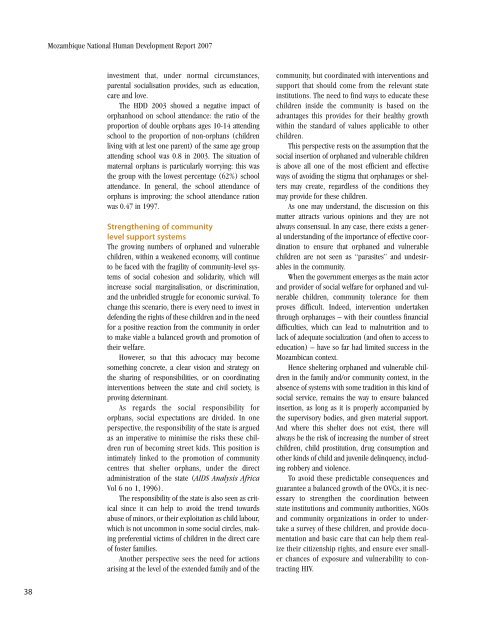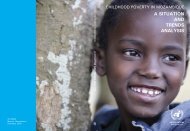Mozambique National <strong>Human</strong> <strong>Development</strong> Report 2007investment that, under normal circumstances,parental socialisation provides, such as education,care and love.The HDD 2003 showed a negative impact oforphanhood on school attendance: the ratio of theproportion of double orphans ages 10-14 attendingschool to the proportion of non-orphans (childrenliving with at lest one parent) of the same age groupattending school was 0.8 in 2003. The situation ofmaternal orphans is particularly worrying: this wasthe group with the lowest percentage (62%) schoolattendance. In general, the school attendance oforphans is improving: the school attendance rationwas 0.47 in 1997.Strengthening of communitylevel support systemsThe growing numbers of orphaned and vulnerablechildren, within a weakened economy, will continueto be faced with the fragility of community-level systemsof social cohesion and solidarity, which willincrease social marginalisation, or discrimination,and the unbridled struggle for economic survival. Tochange this scenario, there is every need to invest indefending the rights of these children and in the needfor a positive reaction from the community in orderto make viable a balanced growth and promotion oftheir welfare.However, so that this advocacy may becomesomething concrete, a clear vision and strategy onthe sharing of responsibilities, or on coordinatinginterventions between the state and civil society, isproving determinant.As regards the social responsibility fororphans, social expectations are divided. In oneperspective, the responsibility of the state is arguedas an imperative to minimise the risks these childrenrun of becoming street kids. This position isintimately linked to the promotion of communitycentres that shelter orphans, under the directadministration of the state (AIDS Analysis AfricaVol 6 no 1, 1996).The responsibility of the state is also seen as criticalsince it can help to avoid the trend towardsabuse of minors, or their exploitation as child labour,which is not uncommon in some social circles, makingpreferential victims of children in the direct careof foster families.Another perspective sees the need for actionsarising at the level of the extended family and of thecommunity, but coordinated with interventions andsupport that should come from the relevant stateinstitutions. The need to find ways to educate thesechildren inside the community is based on theadvantages this provides for their healthy growthwithin the standard of values applicable to otherchildren.This perspective rests on the assumption that thesocial insertion of orphaned and vulnerable childrenis above all one of the most efficient and effectiveways of avoiding the stigma that orphanages or sheltersmay create, regardless of the conditions theymay provide for these children.As one may understand, the discussion on thismatter attracts various opinions and they are notalways consensual. In any case, there exists a generalunderstanding of the importance of effective coordinationto ensure that orphaned and vulnerablechildren are not seen as “parasites” and undesirablesin the community.When the government emerges as the main actorand provider of social welfare for orphaned and vulnerablechildren, community tolerance for themproves difficult. Indeed, intervention undertakenthrough orphanages – with their countless financialdifficulties, which can lead to malnutrition and tolack of adequate socialization (and often to access toeducation) – have so far had limited success in theMozambican context.Hence sheltering orphaned and vulnerable childrenin the family and/or community context, in theabsence of systems with some tradition in this kind ofsocial service, remains the way to ensure balancedinsertion, as long as it is properly accompanied bythe supervisory bodies, and given material support.And where this shelter does not exist, there willalways be the risk of increasing the number of streetchildren, child prostitution, drug consumption andother kinds of child and juvenile delinquency, includingrobbery and violence.To avoid these predictable consequences andguarantee a balanced growth of the OVCs, it is necessaryto strengthen the coordination betweenstate institutions and community authorities, NGOsand community organizations in order to undertakea survey of these children, and provide documentationand basic care that can help them realizetheir citizenship rights, and ensure ever smallerchances of exposure and vulnerability to contractingHIV.38
The General Threat posed by HIV and AIDS to the Country’s FutureBox 6.1What communication strategies in a context of cultural diversity?During the initial years of the post-independence period, undera socialist approach to the promotion of development andnational welfare, the country invested in attempts to suppresssocio-cultural values, expressed under reductionist headingsand labelled as “archaic”, “obscurantist” and “traditionalist”,which, in the dominant perspectives of the time, clashed withthe modernizing values of so-called “scientific” socialism.Despite this, efforts at reconciliation with these cosmologieswere among the first steps taken in the process of opennessand democratising the country, which characterizes the presentconjuncture.During the political opening of Mozambique, begun in themid-1980s, AIDS appeared, and with it, the country embarkedon the invention of the modus operandi of neo-liberal societies,establishing and adopting policies in response to AIDS, underlyingwhich are the <strong>language</strong> and terminologies of practicesand forms of social structuring that are currently hegemonic inwestern culture, such as “democracy” which must doubtlessalways be accompanied by a strong “civil society” and by consultationand involvement of various social strata.When the AIDS crisis set in, at a moment of change in thepolitical and ideological conjuncture, a space was opened forthe start of a process of looking at aspects that, under thesocialist regime, were regarded as hidden and unworthy of consideration,such as the diversity of socio-cultural practices,which were pigeonholed into the universe of “obscurantism”and of supposedly “archaic” values which ought to be suppressed.From the ostracisms and denial which the country tried toestablish with its cultures (at least formally since, in practice,various subterfuges were used by communities to continuallymanipulate cultural values and references) the country movedon, with the advent of AIDS, to encourage a questioning stance,and even a re-invention of bits and pieces of aspects held asculturally characteristic to compose a framework for understandingthe phenomenon of AIDS. Thus, also as a function ofHIV, the cosmologies and social and cultural values ofMozambicans were declared as important in order to producean “informed basis” on which the national response to HIV andAIDS could rest.Studies and research into the behaviour, attitudes andpractices of Mozambicans were promoted. An ethnographiclook into various population groups, particularly as regards sexuality,is being encouraged. The results of these studies andreflections, most of which are of a quantitative nature, are contributingto nourish the repository of representations that characterizeMozambican society.Even so, the policies, strategies, and above all the messages,reflect more the emphases that are circulating globallyabout the forms and methods of combating HIV and AIDS, andless the forms of dialogue with the multiple stereotypes andrepresentations that circulate about HIV and AIDS among thevarious population groups and categories in Mozambique.However, the impact of the data concerning knowledgeabout attitudes and practices is, in itself, relatively limited forstimulating the change of behaviour desired by the programmescombating AIDS. In general, the actions undertakenassume the theory of rational choice, based on which it isbelieved that the availability of adequate information about therisk of HIV infection, transmitted through argued persuasion,would be sufficient in itself to encourage rational decision making,which would end up leading to a change of behaviour, andthus to a significant decline in the risk of infection.But what the numbers don’t say is that alongside the representationsof HIV and AIDS regarded as correct, there isanother repository of values and meanings which are beingbuilt and rebuilt as the national response against AIDSadvances, and which do not necessarily meet the expectationsor teachings of those who promote and implement thatnational response.These cognitive mismatches should not be seen as deviationsfrom the standards it is intended to promote, as somehave argued when they interpret the competing perceptions ofpeople on what was taught about condoms, for example, as“ignorance”, despite the “clear messages” that were “widely disseminated”.If, on the one hand, we assume that the numbers and datatransmitted have their methodological rationale and validity asreference models of social thought and behaviour, on the otherhand, the contradictions, that which the numbers do not catch,the so-called preconceptions and stereotypes, are also ways oftranslating the complexity of meanings and values that glidethrough the socially imagined world, and that should be takeninto consideration when weighing up the advances and setbacksin the national response against HIV and AIDS.However this may be, it cannot be forgotten that theinvestment made in making the socio-cultural dimension standout, as an important factor for understanding the phenomenonof AIDS is significant, and made it possible, in a singular way, toexpress verbally some questions associated with notions ofhealth, disease and sexuality.With this investment, aspects concerning the rites of“purification” (such as pitakufa), the behaviour of witchdoctors,characteristics of polygamy in the south and north of the country,notions of sexual guidebooks, meanings and motivationsfor sex between people of different generations, systems andnetworks of inter-family solidarity, and many other aspects thatcrisscross the territory of culture, sexuality, morals and ethics,have been scrutinized.But recognizing the existence of elements that characterisethe socio-cultural universe, and even cognitive and cosmologicalsystems that coexist, and forms of their production andreproduction, as the national response against AIDS has doneso far, is still not the same as holding a dialogue with them inpolitical and pragmatic terms.Assuming that in society we are not faced with a blankslate, on which we can write and prescribe codes and values,and expect these codes to be assimilated in an intact fashion,then perhaps we should pay more attention to cognitive andinterpretative nuances, to what appears to be a simple contaminationof the social, and also bring these factors and their basesas a constituent part of the dialogue of values and meaningsthat it is intended to advance, in the context of an epidemicthat still shows no sign of slackening.This should not be taken as an effort to essentialise or crystalliseculture, but on the contrary, an investment in order toelevate the capacity or change and for the cohabitation of valueswithin people in society.39
















